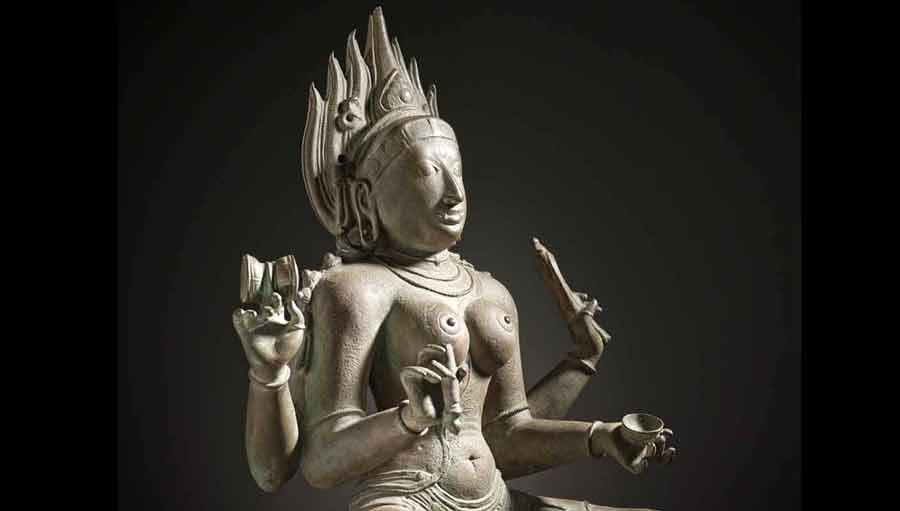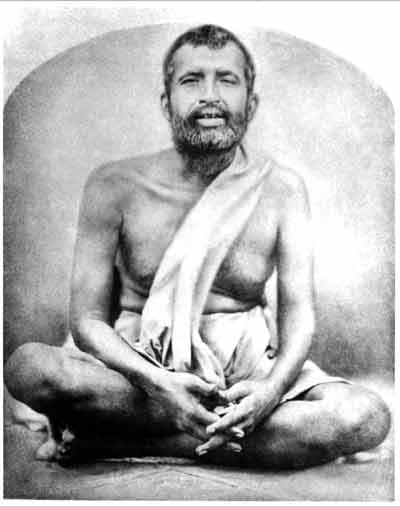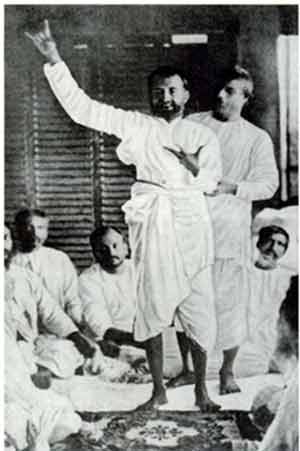
The Hindu Goddess Kali, 11th Century, Tamil Nadu. LACMA
Hinduism is the third largest religion in the world, and probably the most misunderstood. This was of little consequence in the United States as recently
as half a century ago, though there have been periodic bursts of interest since Ralph Waldo Emerson first became enamored of the Upanishads. Today, though,
more than two million Hindus of Indian origin live and work side by side with their fellow American citizens, Hindu temples, like synagogues and mosques
before them, have cropped up in cities and suburbs throughout the country, and Americans increasingly do business in India. In addition, millions of
non-Indian Americans are engaged in Hindu-related practices such as yoga and meditation, for both spiritual and secular reasons. In this context, what
might otherwise seem like a narrow scholarly debate about a long-dead mystic takes on extraordinarily broad significance.
Swami Tyagananda and Pravrajika Vrajaprana’s Interpreting Ramakrishna is a painstaking attempt to refute the central theses of a scholarly book —
Jeffrey Kripal’s Kali’s Child: The Mystical and the Erotic in the Life and Teachings of Ramakrishna — published sixteen years ago, one that roiled
political and cultural waters academic volumes seldom disturb. Based on Kripal’s doctoral dissertation, Kali’s Child took as its subject the
legendary nineteenth-century mystic Sri Ramakrishna. Ramakrishna was one of the most colorful, enigmatic, and revered holy men in India, where such figures
are as much a part of the landscape as the ornate temple towers looming above dusty villages or the unassuming shrines tucked into alcoves in teeming
cities. Intrigued by the man so many consider a modern saint, Kripal set about dissecting the sage’s psyche with the scalpel of psychoanalytic theory. What
he believed he uncovered at the secret heart of Ramakrishna’s life and work was homoeroticism and sexual abuse.
Objections to academic texts are typically voiced by the author’s colleagues in journals, books, and conferences. But Kripal’s conclusions were different,
because Ramakrishna is worshiped by devotees in both India and the West, because he is regarded as a great holy man by spiritual seekers of all kinds,
thanks to the chain of centers established in his name by his chief disciple, Swami Vivekananda, and by illustrious Western devotees like Christopher
Isherwood, and, finally, because much of India still harbors Victorian attitudes toward sexuality, especially of the same-sex variety. The reaction of many
Hindus to Kripal’s thesis was similar to that of certain Christians to Martin Scorsese’s The Last Temptation of Christ, or to those who speculate
about what Jesus and Mary Magdalene may have been up to when the other apostles weren’t looking. To attribute sexual impulses to a figure many consider a
divine avatar — or at least an exemplar of self-realization who had transcended base desires — was, to some minds, an insult verging on blasphemy. Some
critics treated Kripal to the same facile psychoanalysis that they accused him of applying to Ramakrishna. Attempts to ban his book went all the way to the
Indian Parliament. He was even personally threatened in the closest thing to a fatwah that one can imagine in the land of Gandhi.

Ramakrishna Paramhansa
Kripal’s critics within the academy were less emotional, disagreeing with his conclusion on intellectual and methodological grounds or dismissing his
assertions as mere speculation, but they were the minority. Most scholars of religious studies greeted Kali’s Child with kudos, and the book was
honored with prestigious awards. Even those who were indifferent to the subject matter rallied around Kripal on the grounds of academic freedom. For his
part, Kripal maintained that he held Ramakrishna in the highest regard and was merely doing what any scholar should: analyzing a phenomenon through a
particular theoretical lens and following the inquiry to a well reasoned conclusion.
To scholars, disagreement and argument is both expected and desirable. But book banning? Personal attacks? Threats of violence? Beyond the pale. In a
name-calling standoff, Kripal’s critics were labeled homophobes, Hindu fundamentalists, and right-wing Indian nationalists, while his defenders were
branded Hinduphobic, sex-obsessed cultural imperialists. I interviewed both Kripal and the authors of Interpreting Ramakrishna for my own book, American Veda, and can confidently state that none of those charges apply to any of the three. Over time, cooler heads prevailed, but the debate
never died. Kali’s Child became a symbol of the tension between academic critiques of Asian religions and those religions’ practitioners, who
claim that Western interpretations seldom reflect their actual beliefs and practices.
In the light of this controversy, Interpreting Ramakrishna, although it is merely one reaction to one scholar’s take on one Hindu luminary, has
far larger resonance. The book is an exhaustive effort to refute Kali’s Child on its own terms by two monastics in the Ramakrishna order: one an
India-born monk who runs the Vedanta Society of Boston and serves as Hindu chaplain at both MIT and Harvard, the other an American nun at the Vedanta
convent in Santa Barbara. While neither author occupies an academic position or has earned a doctorate, each is deeply immersed in scholarly pursuits. With
the declared intention of playing by academic rules, they took their time, dug deeply, and, 15 years after the appearance of Kripal’s casus belli,
released their multi-pronged rebuttal.
One line of attack in Interpreting Ramakrishna is on Kripal’s translations of the recognized source texts on Ramakrishna. The authors regard the
Bengali-to-English rendering in Kali’s Child as significantly flawed. Kripal contends that his mistakes were few (some were corrected online and
in a second printing) and do not affect his salient arguments. Tyagananda and Vrajaprana beg to differ, arguing that Kripal, consciously or unconsciously,
made linguistic choices that bolstered his predetermined conclusions.
Words and phrases that the respective authors translate differently are many and varied, and they are not inconsequential. Perhaps the best example is the
Bengali phrase k?min? k?ñcana. Previous translators have rendered the phrase “women and gold.” The authors of Interpreting Ramakrishna
say it was often used by Ramakrishna to symbolize lust and greed, or, more generally, the worldly distractions that spiritual aspirants are advised to
avoid. Kripal’s translation is “lover-and-gold.” For Tyagananda and Vrajaprana, this is an attempt to reinforce Kripal’s portrait of Ramakrishna as a
misogynist who feared sexualized women (as opposed to women as maternal figures). Kripal, in turn, accuses translators who use “women” as merely a symbol
for lust of participating in the cover-up of Ramakrishna’s secret homosexuality.
To the lay reader, each side can sound convincing on these issues of textual fidelity. This should not be surprising. Why should Bengali texts be different
from Hebrew, Greek, Aramaic, Arabic, Sanskrit, or any other source of sacred literature whose meaning is debatable? The larger issue is the ambiguity of
translation itself. Try as they may to be objective, translators invariably bring a boatload of cultural and ideological assumptions to their work, and
that is a matter of no small import in any conversation about religion.

Ramakrishna at Belurmath shrine with students
Tyagananda and Vrajaprana also go after Kripal’s reliance on psychoanalytic theory. The question of whether any Western framework is entirely adequate for
understanding Hinduism is a matter of considerable debate, but when the theory in question is as provocative as Freud’s, the atmosphere gets even more
contentious. Are psychoanalytic concepts universal enough to be applied by anyone, much less by a non-psychoanalyst, to a Hindu renunciate who lived over a
century ago in a culture vastly different from Freud’s Europe or today’s America? As with translation, this is a matter for scholars to adjudicate.
Non-experts can readily see the appeal of Freudian ideas, but they can also see why those concepts might produce an incomplete portrait of an individual,
or even a radical distortion. At issue, among other things, is the relationship between the erotic and the mystical. That the two are connected is easy
enough to see; that they are inextricably and causally linked, as Kripal would argue, is a leap that many — including the authors of Interpreting Ramakrisha — are unwilling to take. To them, Freudian interpreters of religion are the proverbial hammer carriers, finding nails
wherever they look.
Finally, Tyagananda and Vrajaprana accuse Kripal of making bold assertions that are unsupported by the available evidence. In their view, Kali’s Child is more a product of speculative imagination than of rigorous deduction, the inference being that Kripal’s conclusions owe more to
his own psyche and his philosophical biases than to the facts at hand. Needless to say, Kripal’s supporters make the same claim about Ramakrishna’s
devotees, many of whose descriptions of the master can accurately, and unsurprisingly, be described as hagiographic.
I myself do not approach these disputed issues as either an academic or an expert on the life of Ramakrishna. But I have more than passing interest in how
religions, especially Hinduism, are understood by the general public, and so I am glad that Tyagananda and Vrajaprana have presented their argument in
painstaking detail and readable prose. I hope that academic scholars, for their part, will critique their work honestly and vigorously and let the chips
fall where they may, rather than summarily ignoring the book because the authors are devotees and not fellow academics. That would be a shame, as their
voices, like Kripal’s, deserve to be heard.
For a long time, something called “the insider-outsider debate” has raged in the ivory towers of religious studies. To religious practitioners
(“insiders”), scholars of religion who rely primarily on textual analysis (“outsiders”) lack the direct experience necessary to comprehend spiritual
beliefs and practices. For their part scholars tend to see insiders as lacking the objectivity necessary to see their own religions without nearsighted
distortion. Each side makes a strong case, and each is weighted down with preconceived notions. Which begs the question: Is there any such thing as
objectivity in matters of religion? As the authors of Interpreting Ramakrishna themselves acknowledge, “objectivity cannot exist where personal
interests, agendas, political and religious biases, and personal priorities intersect. Like all holy grails, true objectivity exists only in mythology.”
One wishes that statement could be read before every clash over religion begins.
Adherents of Christianity, Judaism, and Islam have also been perturbed by scholarly depictions of their faiths, but Hindus are at a particular
disadvantage. Very few have been trained in Western schools of religious studies, and their tradition has not been well represented in the academy. In
recent decades, the imbalance has been somewhat ameliorated by the advent of Western practitioner-scholars — mainly Baby Boomers who got involved with
Hindu-derived teachings during the sixties and seventies and went on to graduate school. But there is still a dearth of religious studies scholars who were
born into Hinduism. Lay scholars, primarily Hindu Americans of Indian descent, have attempted to pick up the slack, and they have not always been welcome.
It goes without saying that in a global, plural world it is vitally important that individuals come to understand religions other than their own. That
understanding will be derived, in large part, from university-based scholars, but if those scholars ignore the insiders’ viewpoint, what they teach the
rest of us is bound to be incomplete. As someone who stands outside both traditional religion and academia and benefits immensely from both perspectives, I
can only hope that diligent insiders, such as the authors of Interpreting Ramakrishna, can find a place at the table, where their work can be
judged on its merits. These researchers appear to have left no stone unturned, and their Herculean effort should add a significant voice to Ramakrishna
studies (yes, there is such a sub-discipline) and to our understanding of modern Hinduism in general.
As for the holy man at the center of the controversy, I suspect he would view it all with amusement and sublime detachment. To generations of seekers,
Ramakrishna remains the most versatile of mystics — a saint for all seasons, and a symbol of ecstatic devotion, rational nondualism, and elastic, eclectic
spirituality. He not only espoused the core Vedic dictum, “Truth is One, the wise call it by many names,” but lived it by diving into a variety of Hindu
pathways and practices, as well as, famously, Islam and Christianity. For the millions who continue to draw inspiration from Ramakrishna’s life and work,
the claims of Kali’s Child and the counterclaims of Interpreting Ramakrishna are sideshows. To them, the sage’s sexuality — whether
conscious or unconscious, acted upon or sublimated, homosexual or heterosexual — is about as relevant as Michelangelo’s or Bach’s. What matters in the end
is not his sexual proclivities but what he did, what he created, what he became. I suspect the authors of both Interpreting Ramakrishna and Kali’s Child would agree.
Originally published in
https://lareviewofbooks.org/article/the-most-versatile-of-mystics/